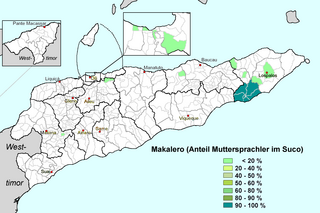|
Makalero
Makalero or Maklere is a Papuan language spoken in the Lautém district of East Timor. It was previously considered to be a dialect of Makasae, but is nowadays seen as a separate language, both by its speakers and linguists.[1] PhonologyThe data in this section are from Huber (2017).[1] VowelsMakalero has five vowel phonemes. Most long vowels occur in predictable contexts; thus Huber argues long vowels are marginal phonemes at best.
Syllables are commonly CV; some are CVC. Epenthetic vowels are often inserted between series of two consonants, and echo vowels are often added to the end of phonological phrases. ConsonantsMakalero has 11 native consonant phonemes.
GrammarAll information in this section is from Huber 2011.[2] Lexical CategoriesMakalero does not have a definitive noun/verb distinction. Nearly all content words can be heads of NPs as well as predicates. In the following examples, isit can be a predicate or a nominal. Ki-isit=ee 3:POSS-ill=DEF hai NSIT k-ua-misa 3:UND-on.top:RED-go.up [2]: 98
'His illness got worse' (lit. went up on top) Content words must be bimoraic, unlike function words, which may be monomoraic. ValencyMakalero has only avalent verbs and divalent verbs. There are no trivalent verbs; instead, biclausal constructions are used. The avalent verbs are adverbial verbs such as atanana 'first,' hana’e 'a long time ago,' aire’ 'now,' kamunei 'tomorrow,' mu’it 'for a long time,' raine’ 'last night,' and tone’ 'maybe.' Divalent verbs allow for a subject and either an object or complement. In the following example, Kiloo is the subject and ani is the object. In the following example, ani is the subject and rau-rau is the complement. Numerals
Notes
References
External links
|
||||||||||||||||||||||||||||||||||||||||||||||||||||||||||||||||||||||||||||||||||||||||||||||||||||||||||||||||||||
Portal di Ensiklopedia Dunia
